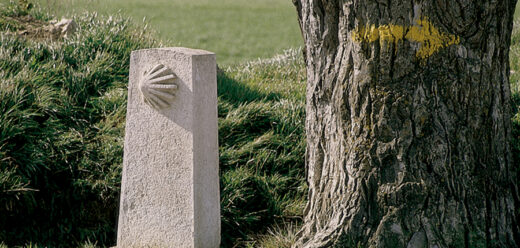
It is impossible to talk of human evolution without making special reference to the Paleontological and archaeological sites of Atapuerca. Following its statement in 2000 as a World Heritage Site of UNESCO, it promoted the building of the current Human Evolution Complex, located in the centre of the city of Burgos, and which the Museum of Human Evolution , the Auditorium and Congress, Burgos Development Forum and the National Research Centre on Human Evolution (CENIEH).
Since its inauguration, the Human Evolution Complex has become a major tourist attraction as well as a generator of economic activity, which is turning Burgos in one of the favourite destinations for congress tourism.
Links of interest: www.museoevolucionhumana.com / www.forumevolucion.es / www.cenieh.es
The Camino de Santiago, near the Cathedral and the Atapuerca, is one of the assets declared World Heritage that Burgos possesses. This condition of historic crossroads of the pilgrimage route gives the city a constant traffic of pilgrims and tourists who contribute to Burgos has become one of the main tourist destinations inside Spain, thereby generating significant economic development of the sector.
The territorial origin of the Spanish language is one of the intangibles that Burgos possesses in its vast cultural, artistic and historical heritage. Within the above it coordinates interesting projects and economic activities for promoting culture and education such as Merimee de Sebastian centenary courses for foreigners.
Burgos Airport (IATA code: RGS, OACI code: LEBG) is an AENA Spanish airport, situated on an extensive plain on the eastern zone of the city of Burgos. In 2014, according to AENA, it provided service to 21,583 passengers (representing an increase of 14.2% compared to 2013) with 2,418 flight operations, 4.9% more than in 2013. These figures represent a recovery after a sharp decline in 2012 and 2013. Despite its recent opening in 2011 it exceeded the number of annual commercial passengers to other surrounding airports, such as Vitoria and Logroño, and others on the mainland, such as Albacete, Cordoba and Huesca. In 2013, it exceeded for the first time in its history, the number of passengers to Salamanca. In 2012, it was proposed to the city of Burgos the condition of European multimodal platform, combining goods by road, rail and aviation. Villafria is home to the maintenance of Aeronova company, where the entire fleet is situated. This company will also operate charter flights from the airport during the summer.
The new airport facilities consist of:
A terminal area. A passenger terminal building of 2,326 square meters, with 4 check-in counters, a baggage conveyor belt, two departure gates, cafeteria (to be awarded) and Aena offices. It has a capacity of for 350,000 passengers per year. A multi-service building of 1,922 m² for fire prevention service, air cargo offices of the centre and power plant. A parking lot with 188 parking spaces. Access control and pump cabins.
Airfield. A 2,100 x 45 meters runway, with 04-22 orientation. An aircraft parking lot of 22,336 m2, with capacity for two C type aircraft, one D-type, three parking areas for general aviation and one for helicopters. Three taxiways: a parallel runway and another perpendicular, that connect to the platform; and also a third taxiway that connects to the old airport facilities (platform, terminal and hangar), to be used for general aviation and airport and industrial zone.
.






